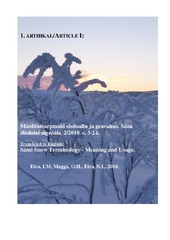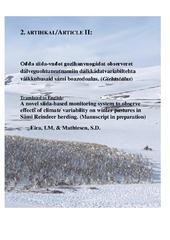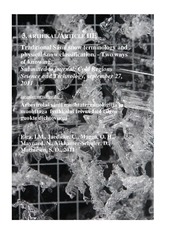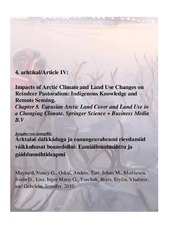| dc.contributor.advisor | Magga, Ole Henrik | |
| dc.contributor.author | Eira, Inger Marie Gaup | |
| dc.date.accessioned | 2016-10-13T13:10:59Z | |
| dc.date.available | 2016-10-13T13:10:59Z | |
| dc.date.issued | 2012-05-31 | |
| dc.description.abstract | OKTIIGEASSU: Dát doavttergrádabargu lea gielladutkan fágaidrasttideaddji perspektiivvas, man ulbmil lei guorahallat sámegiela muohtadoahpagiid sisdoalu ja geavahusa dálveguohtundiliid birra sámi boazodoalus, Guovdageainnus, Norggas. Doabaanaliisavuođđun lean geavahan informántadieđuid, gielalaš ja muohtafysihkalaš beliid ja boazodoallomáhtu ja nu ovttastahttán árbevirolaš eamiálbmotmáhtu fysihkkamihtidemiiguin. Dáidda lassin lean ráhkadan siida-vuđot gozihanvuogádaga, man vuođđun lea boazodoalu fágagiella, mas viđa siidda boazovázzit geavahedje guođohanbeaivegirjji gozihit beaivválaččat muohtadiliid, biekka, arvvi/muohttaga, ealu láhttema relaterejuvvon duovdagiidda. 318 muohtaguoskevaš doahpaga, mat guovllus geavahuvvojit, sisdollet eavttuid mat sihke duddjojit bohcco ceavzimii ja ahtanuššamii, ja maiddái olbmo bargovejolašvuođaide. Doahpagiid dovdomearkačoahkit gullet sihke boazodollui ja muohtafysihkkii ja daid máŋggadimenšunála sisdoallu čájeha muhtumiin čielga muohtafysihkkadovdomearkkaid nugo riikkaidgaskasaš muohtaklassifikašuvnnain leat ja earát fas gullet guođohanstrategiijaide. Kompleaksa kategoriija muohtadoahpagat sisttisdoallet oktanaga ollu fáktoraid nu go dieđuid muohttaga, muohtadiliid, muohtafysihka, dálkki, temperatuvrra, báikki, áiggi ja bohcco/olbmo váikkuhusaid birra. Muohtadoahpagat leat dehálaččat beaivválaš boazobarggus, mat leat dehálaš oasit boazodoalu árbevirolaš máhtus. Boazovázzit observerejit ja hálddašit muohttaga guovtti perspektiivas, muohtafysihka mielde ja ealu ekologiija mielde dálveguohtoneatnamiin, mii mearkkaša ahte sis lea ollislaš muohtamáhttu ja –oaidnu. Goziheami bohtosat čájehit ahte dálveguohtuneatnamiid geavaheapmi lea strategalaš ja systemáhtalaš báikki ja áiggi dáfus ja ahte leat stuora erohusat Oarje-Finnmárkku siiddaid muohtadilliin jagiid ja báikkiid ektui, mii váttisin dahká buohtastahttit nuppi siidda dili nuppiin ja generaliseret dilliid. Doabageavaheapmi speadjalastá boazovázziid árbevirolaš máhtu hálddašit kompleaksa vuogádagaid ja barget ealuin dálvemáilmmis. Dát sáhttá váikkuhan boazodoalu seailumii doloža rájes dássážii. Muohtadoabaanaliissat čájehit ahte lea dehálaš geavahit boazodoalufágagiela ja -fágaterminologiija boazodoalu hálddašeamis ja hálddahusas. Riikka heivehanstrategiijaid oktavuođas ferte boazodoalu árbevirolaš máhtu váldot vuhtii, ja dálkkádatrievdamiid dustema heivehanstrategiijaide fertejit boazodoalu kultur- ja giellavuoigatvuođat váldot mielde. Dát gáibida iešguđetlágan máhtu, ja dan dihte ferte ovttastahttit sihke eamiálbmot boazodoalloárbevirolaš máhtu ja oarjemáilmmi dieđalaš máhtu. Čoavddasánit: sámegiella, muohtadoahpagat, guohtun, boazodoalu fágagiella, árbevirolaš máhttu, muohtafysihkka, dálkkádat. | en_US |
| dc.description.abstract | This thesis is a linguistic study with an interdisciplinary perspective with the aim to investigate the content and the use of Sámi snow concepts about grazing conditions for reindeer on snow covered ground in Sámi reindeer herding in Guovdageaidnu, Norway. As basis for the analysis of snow concept, interviews, linguistics, and physical aspects and reindeer herders’ knowledge was used, thus combining indigenous people’s knowledge and snow physic measurements. In addition, a siida-based monitoring system based on herders’ specialist language was developed, where herders from five different siidas used herding diaries in monitoring and making daily observation of variations in snow condition, wind, precipitation, topography related to herd behavior and welfare. 318 snow related concepts used by reindeer herders in this area, contain factors that affect reindeer survival and sustainability, well-being of reindeer and the human working conditions. The concepts contain a set of characteristics belonging to reindeer herding and snow physics, and their multidimensional content show that some concepts are based on the physical characteristics of snow and can therefore be compared with international snow classification, while others have elements connected to the different herding strategies. Some snow concept are complex categories in the sense that a term contains and includes many factors simultaneously, such as information of snow, snow conditions, snow physics, weather, temperature, location, time and impacts of animals and humans. Snow concepts are central for daily work with the reindeer, and constitute important parts for reindeer herders’ traditional knowledge. Reindeer herders observe and manage snow from two perspectives; the snow physics and the ecology of herds in the winter grazing area, which reveals a holistic knowledge and view. The data indicate strategic and systematical use of grazing areas in terms of time and space and, shows variability between the siidas in terms of snow conditions between years and between pasture areas. Every winter siida has its unique grazing condition, which makes it difficult to compare one siidas grazing condition with others, and draw general conclusions. The use of Sámi snow concepts mirror reindeer herders’ traditional knowledge of the management of the herd on snow covered ground and how herders deal with these complex systems. This kind of knowledge has contributed to the survival of reindeer herding since time immemorial. The analysis of snow concepts show the importance of using Sámi reindeer herders’ specialist language and traditional knowledge in mainstream the governance of reindeer herding. Thus the national adaptive strategies must recognize reindeer herders’ traditional knowledge, and their cultural and linguistic rights must be included in adaptation strategies for climate change. This requires different ways of knowing, combining both herders’ experienced-based knowledge and scientific knowledge. Keywords: Sámi language, snow concepts, guohtun, reindeer herding specialist language, traditional knowledge, snow physics, climate. | en_US |
| dc.description.doctoraltype | ph.d. | en_US |
| dc.description.popularabstract | Dette er en studie om snø, samisk språk og reindrift, i et tverrfaglig perspektiv. Forståelsen og bruken av samiske snøbegreper om reinens beiteforhold er undersøkt i en tid hvor klimaendringene påvirker arktiske urfolk. I studien, som er gjennomført i Guovdageaidnu, er det brukt lingvistiske og fysiske undersøkelser hvor reingjeternes tradisjonell kunnskap er inkludert. Som et bidrag til å overvåke fremtidige snøforandringer i beiteområdene er det utviklet et siida-basert system hvor reindriftens fagspråk danner grunnlaget for overvåkingen. Fem ulike vintersiidaer brukte gjetedagbøker på samisk til å overvåke snøforhold, vind, nedbør, topografi relatert til flokkens adferd og velferd. I Guovdageaidnu brukes 318 begrep om snø og reindrift, der disse inneholder faktorer som påvirker reinens overlevelse og velferd og reingjeterens arbeid med flokken. I begrepene finnes kunnskap både om reindrift og snø. Noen av begrepene inneholder fysiske egenskaper og kan derfor sammenlignes med internasjonale snøklassifiseringer, mens andre snøbegrep har elementer knyttet til ulike gjetestrategier. Enkelte snøbegrep er komplekse kategorier som omfatter mange faktorer samtidig, for eksempel informasjon om snøfysikk, vær, temperatur, sted, tid og påvirkninger av dyr og mennesker. Snøbegrepene er sentrale for det daglige arbeidet med reinflokken, og utgjør viktige deler av reindriftsutøvernes tradisjonelle kunnskap. Reindriftsutøverne observerer og forvalter snøen fra minste to ulike perspektiver; snøens fysiske tilstand og reinens økologi på vinterbeiteområdet. Dette viser reineiernes helhetlig forståelse av kunnskap om reindriften. Reindriftsutøverne bruker sitt reinbeiteområde strategisk og systematisk i forhold til tid og sted, som viser variasjoner mellom siidaene i forhold til snøforhold mellom år og mellom beiteområder. Hver vintersiida har sine unike beiteforhold, noe som gjør det vanskelig å sammenligne en siidas beitetilstand med en annen, og trekke generelle konklusjoner. Bruken av samiske snøbegrep gjenspeiler reindriftsutøvernes tradisjonell kunnskap om forvaltningen av flokken og hvordan de håndterer disse komplekse systemene. Denne type kunnskap i det samiske språket, slik som goavvi, har vært med å bidra til overlevelse av reindrifta i uminnelige tider. Analysen av snøbegrepene viser viktigheten av å bruke reindriftssamenes fagspråk og tradisjonelle kunnskap i forvaltningen av reindrift. Derfor må nasjonale tilpasningsstrategier til fremtidige klimaendringer anerkjenne reindriftsutøvernes tradisjonell kunnskap, og deres kulturelle og språklige rettigheter. Derfor bør ulike kunnskapsformer inkluderes i forvaltningen av reindriften, både reineiernes erfaringsbasert kunnskap og vitenskapeligbasert kunnskap. | en_US |
| dc.description.sponsorship | This study has been a part of The EALÁT project financially supported by Norwegian Research Council grant number 176078/S30, Ministry of Government Administration, Reform and Church Affairs, and hosted at and led by Sámi University College and the International Centre for Reindeer Husbandry. | en_US |
| dc.identifier.uri | https://hdl.handle.net/10037/9843 | |
| dc.identifier.urn | URN:NBN:no-uit_munin_9220 | |
| dc.language.iso | eng | en_US |
| dc.language.iso | smi | en_US |
| dc.publisher | Universitetet i Tromsø | en_US |
| dc.publisher | University of Tromsø | en_US |
| dc.rights.accessRights | openAccess | |
| dc.rights.holder | Copyright 2012 The Author(s) | |
| dc.rights.uri | https://creativecommons.org/licenses/by-nc-sa/3.0 | en_US |
| dc.rights | Attribution-NonCommercial-ShareAlike 3.0 Unported (CC BY-NC-SA 3.0) | en_US |
| dc.subject | VDP::Humaniora: 000::Språkvitenskapelige fag: 010::Samisk språk: 031 | en_US |
| dc.subject | VDP::Humanities: 000::Linguistics: 010::Sami language: 031 | en_US |
| dc.title | Muohttaga jávohis giella. Sámi árbevirolaš máhttu muohttaga birra dálkkádatrievdanáiggis/
The Silent Language of Snow. Sámi traditional knowledge of snow in times of climate change. | en_US |
| dc.type | Doctoral thesis | en_US |
| dc.type | Doktorgradsavhandling | en_US |


 English
English norsk
norsk




